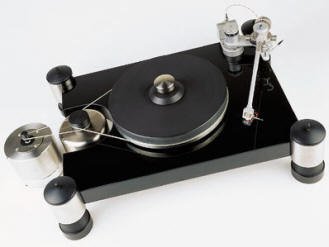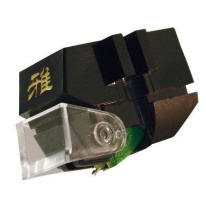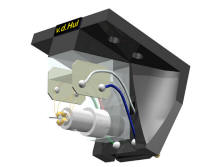You are reading the older HTML site
Positive Feedback
ISSUE
22
The Search for the
Ultimate Cartridge
by Roger S. Gordon
Choosing a phono cartridge can be a frustrating experience. While there are many wonderful cartridges, at all price points, being able to listen to or compare them is difficult. Not all high-end dealers carry analog gear. Those who do may only carry the more popular ones. And even if your dealer carries a cartridge on your list, will it sound the same in your system as it does in the showroom? The sound of a cartridge is highly system dependent. A cartridge that sounds great on one tonearm may sound less than stellar on another. This is not because the second tonearm is bad, but because the synergy is simply not there. What is a vinyl lover to do?

A little over a year ago, I upgraded my VPI HW-19 Mk IV to a used VPI TNT--V HR with VPI 12.5 tonearm, and began my quest for the ultimate phono cartridge. Via the web, I purchased a used Van den Hul Colibri XGW (1) that had just been to the Van den Hul factory for its 300-hour tuneup. (One of the unusual features of the higher-priced Van den Hul cartridges is that after you have used one for 300 hours, you have the option to return it to the factory for a tuneup.) The Colibri was stunning in my system, and certainly sounded better than the Benz Micro Reference that it replaced. The only weakness I noticed was that it was a little light in the bass, so I continued my search by buying a grey-market Benz Micro LP Ebony via Audiogon. In my system, the LP Ebony sounded significantly better than the Benz Micro Reference, but did not have the magic of the Colibri. I sold it to a fellow in Germany, who wrote back that he was extremely happy with it.
I then bought a ZYX
Airy2 SB, which had been getting a lot of buzz in the vinyl chat rooms. The
Airy2 was impressive—smooth and silky, and very detailed without being
etched. While there was much to love about the Airy2, it was a little
reserved for my taste. When I played my heavy metal albums, I just wasn't
banging my head the way I should. The sound was beautiful, but it did not
excite me. While engaging in negotiations to trade in the Airy2 in for a ZYX
UNIverse, I purchased a used Koetsu Urushi Vermillion via Audio Asylum. I
had always heard about the lush Koetsu sound, but had never had an
opportunity to hear one. Now was my chance. The Urushi needed substantial
break-in—I put over sixty hours on it before the sound stopped changing.
During this time, I often worked in another room while playing LPs, and
would have to stop what I was doing and go into the listening room. That
gorgeous Koetsu midrange just had to be experienced. I now understood why
people fall in love with Koetsus. If I listened only to orchestral and big
band music, the highly seductive Urushi would be at the top of my list, but
its weaknesses/colorations were apparent with jazz, rock, and chamber music.
Whiles breaking in the Urushi, I sent an email to the dealer in Germany from whom I had purchased the Colibri, asking if there was a cartridge that had the magic of that cartridge but with more bass. He told me that Van den Hul was coming out with a new cartridge, the Condor, which was a cross between a Frog and the Colibri. He offered to sell me one at a very attractive price, and the thought of having a Colibri with bass was too tempting. The Condor XGM that arrived two months later was part of the first batch to be manufactured. A week later, my ZYX UNIverse also arrived. The Condor took well over a hundred hours to break in. It did have more bass slam than the Colibri, but lacked the Colibri's unique ability to create three-dimensional images within a vast soundstage. After putting several hundred hours on the Condor, it was finally time to listen to the UNIverse.
The UNIverse was stunning right out of the box. I could hear why the vinyl chat rooms were buzzing with praise for it. I had put about 200 hours on the UNIverse when I received a phone call from a friend who had the use of a Miyabi 47 Laboratory cartridge for a few days. Did I want to hear it? The Miyabi was on my must-listen list, along with the Lyra Titan, the Dynavector XV-1s, the Transfiguration Temper, and the Allaerts MC2 Finish. My friend also owns a VPI 12.5 tonearm, and since the 12.5 has a removable arm wand, I was able to bring my wand with the UNIverse mounted and compare the two cartridges. He also has a Condor, and wanted to hear the difference between his Condor and my Colibri. We had a wonderful time listening to the Miyabi and the UNIverse, and after I left, he mounted the Colibri on his arm and listened to it until 2 AM. In his opinion, and in his system, it was not at all bass-shy.
 The next day, he brought
his arm wand and the Miyabi 47, and over the next two days, I spent fifteen
hours doing comparative listening between the UNIverse, the Miyabi 47, and the
Colibri. This was not enough time to get to know the Miyabi 47 intimately, and
with three cartridges and only two arm wands, I could only compare two
cartridges at a time, but I heard enough to understand the relative strengths
and weaknesses of the three cartridges. I checked the alignment of all three
with my Wallytractor, experimented with stylus rake angle and vertical tracking
force to determine the optimal settings, set azimuth using test tones and a
multimeter, then experimented with cartridge loading by changing resistors. My
reference Herron VTPH-1 phono stage was at the factory getting updated, so I
used my Vacuum State JLTI solid stage phono stage. The JLTI has an input
impedance of 23Kohms, and while it allows the user to vary the input impedance
by using RCA plugs with resistors soldered into them, I did not use this option.
My phono cable, a one-off design from Bent Audio, has a terminal block with two
pairs of binding posts for attaching the resistors, so I could quickly change
the loading by swapping pairs of resistors on the terminal block. I also
experimented with torquing the bolts holding the cartridge to the arm wand. With
the optimal torque determined by ear, it was time to compensate for the unequal
outputs of the cartridges. The Miyabi has .3mv of output, while the UNIverse
specs state .25mv. The Colibiri's output can range from .25 to .65, and
according to the box it came in, the output of mine is .45. Using test tones and
a sound pressure meter, I noted the volume control settings that equalized the
readings for all three cartridges. The UNIverse needed only a little bit more
volume than the Miyabi 47, which made sense according to the specs, but the
Colibri required more volume than the UNIverse, leading me to estimate that its
actual output was around .17mv.
The next day, he brought
his arm wand and the Miyabi 47, and over the next two days, I spent fifteen
hours doing comparative listening between the UNIverse, the Miyabi 47, and the
Colibri. This was not enough time to get to know the Miyabi 47 intimately, and
with three cartridges and only two arm wands, I could only compare two
cartridges at a time, but I heard enough to understand the relative strengths
and weaknesses of the three cartridges. I checked the alignment of all three
with my Wallytractor, experimented with stylus rake angle and vertical tracking
force to determine the optimal settings, set azimuth using test tones and a
multimeter, then experimented with cartridge loading by changing resistors. My
reference Herron VTPH-1 phono stage was at the factory getting updated, so I
used my Vacuum State JLTI solid stage phono stage. The JLTI has an input
impedance of 23Kohms, and while it allows the user to vary the input impedance
by using RCA plugs with resistors soldered into them, I did not use this option.
My phono cable, a one-off design from Bent Audio, has a terminal block with two
pairs of binding posts for attaching the resistors, so I could quickly change
the loading by swapping pairs of resistors on the terminal block. I also
experimented with torquing the bolts holding the cartridge to the arm wand. With
the optimal torque determined by ear, it was time to compensate for the unequal
outputs of the cartridges. The Miyabi has .3mv of output, while the UNIverse
specs state .25mv. The Colibiri's output can range from .25 to .65, and
according to the box it came in, the output of mine is .45. Using test tones and
a sound pressure meter, I noted the volume control settings that equalized the
readings for all three cartridges. The UNIverse needed only a little bit more
volume than the Miyabi 47, which made sense according to the specs, but the
Colibri required more volume than the UNIverse, leading me to estimate that its
actual output was around .17mv.
My procedure was to listen to one track on a test album, then swap the arm/cartridge, reset volume, swap resistors, change SRA/VTA, then replay the same track and write down my impressions. I would then play a track of another test album and swap arm wands again. I continued doing this until I had gone through ten test albums. I started my listening with the Miyabi 47 and the UNIverse. then replaced the Miyabi with the Colibri, went through all of the setup procedures, relistened to all of the test tracks comparing the Colibri to the UNIverse. then replaced the UNIverse with the Miyabi 47 and listened to all of the test tracks again.
All of the test tracks had great sound except for the last two, which had average sound. Since most of us have more average-sounding than great-sounding LPs, I thought these would be useful. The tracks were as follows:
Jennifer Warnes, "Bird on a Wire," Famous Blue Rain Coat (Cypress Records 661 111-1)
Peter Townshend, "Pinball Wizard (Unplugged)," The Secret Policeman's Ball (Island 12 WIP 6598)
Johnny Cash, "Delia's Dead," Cash (American Recordings 45520-1)
Nirvana, "Come as You Are," Unplugged in New York (David Geffen Company 24727-1)
Louis Armstrong, "St. James Infirmary" (Classic Records 45rpm)
Joe Satriani, "Surfing with the Alien," Surfing with the Alien (Relativity CRI-08193)
Virgil Thomson, "The Old South," The River (Vanguard/Analogue Productions AP 001)
Rammstein, "Mein Herz Brennt," Mutter (Motor Music 549 639-1)
Twisted Sister, "Wake Up (the Sleeping Giant)," Love is for Suckers (Atlantic 81772-1)
Carl Nielsen, Symphony No. 5, first movement (Columbia MS 6414)
What did I learn from listening to each of these ten tracks six times? The first thing that struck me was how similar the three cartridges sounded in my system. All three retrieved detail. All were musical. All threw a big soundstage. While their differences were not night-and-day, I am willing to bet that in a blind comparison test in a high-quality system, most listeners would be able to tell one from another. I am also willing to bet that most audiophiles would prefer the Miyabi 47, and that music lovers would be split between the UNIverse and the Colibri. The audiophiles would love the Miyabi because it is exciting and dynamic, and places more emphasis on initial transients. It sounds sharper and more hi-fi-ish than the other two cartridges, though not in a negative way. There is ying and yang in music, and both have their place. The Miyabi emphasizes the sound of the music, yet still conveys its musicality. The other two cartridges emphasize the music while still conveying its sound. The only drawbacks of the Miyabi 47 were that its soundstage was not quite as deep as that of the other two cartridges, and was slightly narrower at the back than at the front—in other words, the soundstage was a trapezoid rather than a rectangle. Possibly related to this is the fact that the Miyabi is a little more finicky about setup. Adjusting SRA/VTA for each LP was more important than with the other cartridges. Perhaps if I had spent more time to dial in each record, the soundstage would have expanded.
 The UNIverse slightly
rounds initial transients in comparison with the Miyabi, though not as much as
my Urushi. It sounds smooth and silky, and slightly warmer than the Miyabi. It
makes wonderful music. All of the audiophile criteria are there—soundstaging,
detail, pinpoint imaging, etc.—but music comes first. The Colibri fits between
the Miyabi 47 and the UNIverse. It sounds slightly warmer than the Miyabi, but
not quite as warm as the UNIverse. It is slightly more hi-fI-ish than the
UNIverse, but is still on the side of musicality. Where the Colibri really
shines is in spatial representation. All three cartridges place
three-dimensional images within the soundstage, but the Colibri's images are
more believable, and the overall sound seems more like what I hear in the
concert hall. When playing the Nielsen symphony with the Colibri, I caught
myself headbanging in time with the snare drum, just like I do with my heavy
metal LPs. I usually only headbang with classical music when I am at a live
performance. The downside of the Colibri is that it lacks bass slam. There is
deep, textured bass, but the slam that I want on my heavy metal LPs is just not
there.
The UNIverse slightly
rounds initial transients in comparison with the Miyabi, though not as much as
my Urushi. It sounds smooth and silky, and slightly warmer than the Miyabi. It
makes wonderful music. All of the audiophile criteria are there—soundstaging,
detail, pinpoint imaging, etc.—but music comes first. The Colibri fits between
the Miyabi 47 and the UNIverse. It sounds slightly warmer than the Miyabi, but
not quite as warm as the UNIverse. It is slightly more hi-fI-ish than the
UNIverse, but is still on the side of musicality. Where the Colibri really
shines is in spatial representation. All three cartridges place
three-dimensional images within the soundstage, but the Colibri's images are
more believable, and the overall sound seems more like what I hear in the
concert hall. When playing the Nielsen symphony with the Colibri, I caught
myself headbanging in time with the snare drum, just like I do with my heavy
metal LPs. I usually only headbang with classical music when I am at a live
performance. The downside of the Colibri is that it lacks bass slam. There is
deep, textured bass, but the slam that I want on my heavy metal LPs is just not
there.
During my fifteen hours of listening to these three cartridges, I learned that I no longer needed to continue my frenzied search for the perfect cartridge. Each of the three cartridges gives a slightly different view of the music, but all three views are equally valid and equally beautiful. I could easily live with any of them. If I was stranded on a desert island with only my system and a Miyabi 47, I would be content, but I was not heartbroken that I could only spend two days with it. The UNIverse and the Colibri give me just as much joy. Which cartridge you should buy will depend upon your preferences and your system, but unless you are terminally afflicted with audiophilia nervosa, I believe that you would be content with any of these cartridges. I intend to stop listening to cartridges and listen to music, although if a Dynavector XV-1s, a Lyra Titan i, or a J. Allaerts MC Finish happen to become available, I would not be an audiophile if I said no to a listen. However, there no longer is any pressure to find the ultimate cartridge.
(1) The Van den Hul Colibri and Condor cartridges come in quite a few varieties which can be discerned by the letters following the name. The X stands for the X engine, in which the coils form an X. The middle letter indicates the metal used for the internal wiring: C = copper, G = gold, and P = platinum. According to Mr. Van den Hul, platinum wire sounds the best, but gold does not fatigue as readily and retains its original sound over a longer periode. The final letter is the material the body is made from: M = metal, P = polycarbonate, and W = wood. I have heard, but cannot confirm, that the myrtle wood used was obtained from George Cardas.
